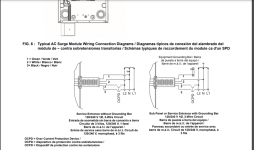gar
Senior Member
- Location
- Ann Arbor, Michigan
- Occupation
- EE
210228-1146 EST
cfg:
Your post #16 I don't have a specific answer.
Following are some results from some quick experiments:
Equipment --- my 1950 GE photographic light meter (probably selenium photovoltaic photocell), a socket assembly with reflector, CREE bulb (2200 K, 800 lumens, 9.5 W, 120 V, 60 Hz, 79 mA) in socket, 123 V and less applied via a variable transformer, end of bulb 18" from photocell, and ambient light less than a fraction of 1 foot-candle.
Experiment Last --- Because of what I saw on my pulse tests I did the following test afterwards on the CREE bulb:
120 V --- 32 ft-c
100 V --- 32 ft-c
080 V --- 32 ft-c
060 V --- 30 ft-c
040 V --- 25 ft-c
020 V --- 15 ft-c
Experiments --- Pulse tests performed at 123 V source with fixed resistor shunted by a mechanical relay contact (silver material not silver-cadmium-oxide). Pulse control of of relay is electronic with both on and off times adjustable. Load 15 W incandescent 120 V in parallel with 9.5 W CREE. Other portion of cycle was 4 seconds,
Experiment 1 --- 20 ohm, 140 mS, 3.6 V drop. 15 W flickered, CREE no flicker.
Experiment 2 --- 20 ohm, 400 mS, 3.6 V drop. 15 W flickered, CREE no flicker.
Experiment 3 --- 20 ohm, -----1 S, 3.6 V drop. 15 W flickered, CREE no flicker.
Experiment 4 --- 60 ohm, 140 mS, 10.6 V drop. 15 W flickered, CREE no flicker.
Experiment 5 --- 60 ohm, 1 S, 10.6 V drop. 15 W flickered, CREE no flicker.
Changed from a normally closed contact on the relay to normally open to change from a voltage drop pulse to a voltage rise pulse. No change in the results.
Tried a FEIT LED bulb with about the same rating as the CREE with the same 60 ohm resistor, and visually the FEIT results were about the same as the 15 W incandescent.
.
cfg:
Your post #16 I don't have a specific answer.
Following are some results from some quick experiments:
Equipment --- my 1950 GE photographic light meter (probably selenium photovoltaic photocell), a socket assembly with reflector, CREE bulb (2200 K, 800 lumens, 9.5 W, 120 V, 60 Hz, 79 mA) in socket, 123 V and less applied via a variable transformer, end of bulb 18" from photocell, and ambient light less than a fraction of 1 foot-candle.
Experiment Last --- Because of what I saw on my pulse tests I did the following test afterwards on the CREE bulb:
120 V --- 32 ft-c
100 V --- 32 ft-c
080 V --- 32 ft-c
060 V --- 30 ft-c
040 V --- 25 ft-c
020 V --- 15 ft-c
Experiments --- Pulse tests performed at 123 V source with fixed resistor shunted by a mechanical relay contact (silver material not silver-cadmium-oxide). Pulse control of of relay is electronic with both on and off times adjustable. Load 15 W incandescent 120 V in parallel with 9.5 W CREE. Other portion of cycle was 4 seconds,
Experiment 1 --- 20 ohm, 140 mS, 3.6 V drop. 15 W flickered, CREE no flicker.
Experiment 2 --- 20 ohm, 400 mS, 3.6 V drop. 15 W flickered, CREE no flicker.
Experiment 3 --- 20 ohm, -----1 S, 3.6 V drop. 15 W flickered, CREE no flicker.
Experiment 4 --- 60 ohm, 140 mS, 10.6 V drop. 15 W flickered, CREE no flicker.
Experiment 5 --- 60 ohm, 1 S, 10.6 V drop. 15 W flickered, CREE no flicker.
Changed from a normally closed contact on the relay to normally open to change from a voltage drop pulse to a voltage rise pulse. No change in the results.
Tried a FEIT LED bulb with about the same rating as the CREE with the same 60 ohm resistor, and visually the FEIT results were about the same as the 15 W incandescent.
.


